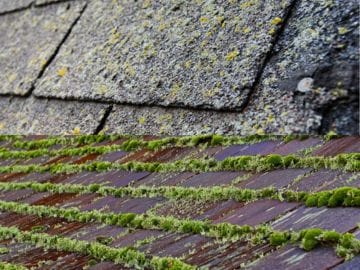Ken Lillejord, our residential and commercial roofing consultant, has been in the roofing business in the Lower Mainland for over 44 years. He knows the ins and outs of different roofing materials and their history, including asphalt shingles.
We have already written about the confusing warranties that shingle manufacturers provide and the different grades of shingles that can be used for residential homes.
Water shedding vs waterproofing
Another point that Ken says homeowners may need help understanding is that your normal sloped residential roof is not meant to be fully waterproofed, unlike flat roof construction which is meant to waterproof the roof completely using a sealed system.
These full waterproofing systems include torch-on roofing, SBS membrane, EPDM, TPO and PVC, plus the old-fashioned and rarely used hot-mopped felt and asphalt ( tar and gravel ) roofing systems. These flat roofing systems all work well at holding out the rainwater when installed correctly with all the right materials and workmanship.
However, a shingled roof is meant to shed water rather than create a waterproof barrier on the roof. Because of the roof slope, rainwater flows down the shingles and is guided toward the eaves, gutters, and drainage zones through overlaps, side laps and layers of roofing material over other lower layers.
Minimum slope needed for shingles
The minimum slope for such systems is typically 4:12 slopes or steeper, which means a 4" rise in each 12" of run. The exception, with a fully waterproof underlayment layer first installed, is low-slope roofs between 2:12 to 4:12. With special detailing and precautions, these low-slope roofs can be completed usually with a special asphalt shingle application system. Metal roofs require 3:12 or steeper in most cases.
Water-shedding roofing systems include metal roofing, slate roofing, concrete and clay cementitious tiles, wood shake, cedar shake and shingles, straw and palm-leaf roofs, simulated polymer, plastic and rubber roofing that are designed to look like cedar or slate roofing, and the most popular and best value which is asphalt shingles.
Construction of asphalt shingles
Asphalt shingles have been with us for around a century. They were invented in 1903 in North America.
Asphalt shingles are a base layer of fabric, now fibreglass, or paper-type base coated with bitumen asphalt. Then their face is covered with slate or ceramic granules with talc, sand or more granules put on the back to keep the products from sticking together. These granules create UV ultraviolet resistance to protect the asphalt from quick and premature degradation, cracking, and aging. The granules have also become an important element of the architectural look and style of many asphalt shingles today.
Early shingles were constructed of ground-up fabrics such as old army uniforms and were called "Duroid" shingles, a name-brand from Domtar. This shingle lay flat and was stable with very little moisture absorption. These shingles tended not to wrinkle and distort as much as in later felt paper versions.
Eventually, a felt paper base became the go-to reinforcement for shingles from the early 1960s until the early 1990s.
Introduction of fibreglass-based shingles
The US market switched first to using fibreglass as the base mat because in the 1980s many states wanted a better fire rating for shingles.
Western Canadian suppliers learned about these new shingles when attending roofing conventions in the US and soon discovered that they lay flatter than what they used at home. They also found these new shingles did not wrinkle or distort as much. So fibreglass-based shingles were introduced to Western Canada in the late 1980s.
These asphalt fibreglass laminated shingles are now the most popular roofing material for Lower Mainland residential homes today, especially the laminated architectural version.









